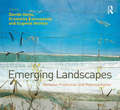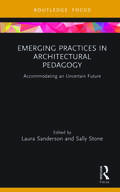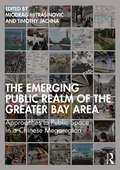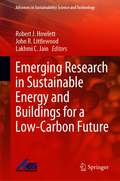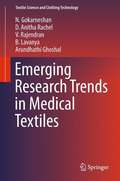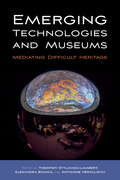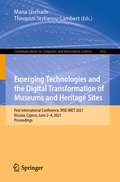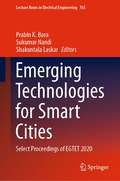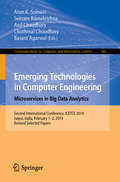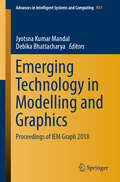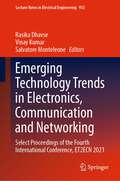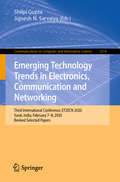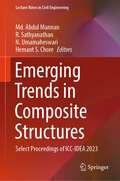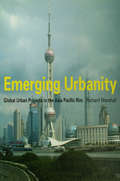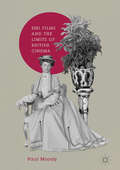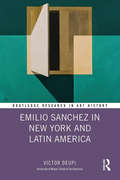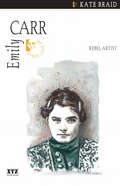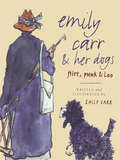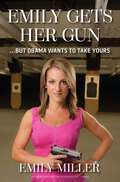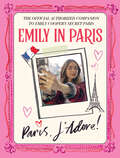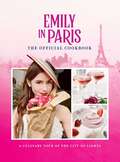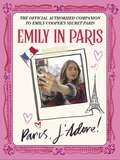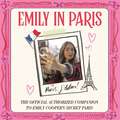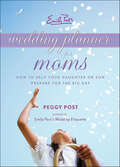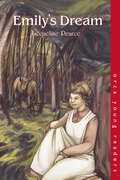- Table View
- List View
Emerging Landscapes: Between Production and Representation
by Davide Deriu Krystallia KamvasinouEmerging Landscapes brings together scholars and practitioners working in a wide range of disciplines within the fields of the built environment and visual arts to explore landscape as an idea, an image, and a material practice in an increasingly globalized world. Drawing on the synergies between the fields of architecture and photography, this collection takes a multidisciplinary approach, combining practice-based research with scholarly essays. It explores and critically reassesses the interface between representation - the imaginary and symbolic shaping of the human environment - and production - the physical and material changes wrought on the land. At a time of environmental crisis and the ’end of nature, ’shifting geopolitical boundaries and economic downturn, Emerging Landscapes reflects on the state of landscape and its future, mapping those practices that creatively address the boundaries between possibility, opportunity and action in imagining and shaping landscape.
Emerging Practices in Architectural Pedagogy: Accommodating an Uncertain Future (Routledge Focus on Design Pedagogy)
by Sally Stone Laura SandersonEmerging Practices in Architectural Pedagogy explores the emergent techniques in architectural education that are helping to bridge the gap between the institutional setting and working practice. It demonstrates how teaching and learning can, and should, be directed towards tackling the real-world problems that students will encounter within their professional careers. Architectural and design practitioners are becoming less specialised, they are embracing cross-disciplinary connections and practical problem-solving. Architecture and design schools must align their teaching to reflect this changing world, and evolve from a fact-based acquisition process to a participatory method of learning. This book uses an extended case-study format to examine large-scale issues. Each chapter represents a specific mode of practice, which is linked to the wider debate on architectural and design pedagogy; this includes collaborative workshops and interventions, issues connected to sustainability and climate change, responses to rapid urbanisation, and, the creation of collaborative relationships across disciplines. The book has an international perspective, with contributions from the United Kingdom, United States of America, and Singapore, and includes a timely discussion on teaching in a remote climate. This book will be an invaluable resource for engaged academics and teaching practitioners interested in playing a key role in the future development of the architectural profession.
The Emerging Public Realm of the Greater Bay Area: Approaches to Public Space in a Chinese Megaregion
by Miodrag Mitrašinović; Timothy JachnaThrough illustrated case studies and conceptual re-framings, this volume showcases ongoing transformations in public space, and its relationship to the public realm more broadly in the world’s most populous urban megaregion—the Greater Bay Area of southeastern China—projected to reach eighty million inhabitants by the year 2025. This book assembles diverse approaches to interrogating the forms of public space and the public realm that are emerging in the context of this region’s rapid urban development in the last forty years, bringing together authors from urbanism, architecture, planning, sociology, anthropology and politics to examine innovative ways of framing and conceptualizing public space in/of the Greater Bay Area. The blend of authors’ first-hand practical experiences has created a unique cross-disciplinary book that employs public space to frame issues of planning, political control, social inclusion, participation, learning/education and appropriation in the production of everyday urbanism. In the context of the Greater Bay Area, such spaces and practices also present opportunities for reconfiguring design-driven urban practice beyond traditional interventions manifested by the design of physical objects and public amenities to the design of new social protocols, processes, infrastructures and capabilities. This is a captivating new dimension of urbanism and critical urban practice and will be of interest to academics, students and practitioners interested in urbanization in China.
Emerging Research in Sustainable Energy and Buildings for a Low-Carbon Future (Advances in Sustainability Science and Technology)
by Robert J. Howlett John R. Littlewood Lakhmi C. JainThis book contains an introduction and 20 studies, each describing a recent research investigation in the area of sustainable and resilient buildings, built environment infrastructure and renewable energy. Contributions are from many different countries of the world and on a range of topics, representing a sample of research within the ‘sustainable energy and buildings’ field. The book begins with chapters on the sustainable design of buildings, followed by descriptions of issues relating to the renovation, restoration and reconstruction of existing buildings, or in one case a railway wagon. The next part of the book covers factors that form barriers or impediments to low or zero carbon buildings, followed by studies of issues relating to policy and certification. There then follow four chapters on various topics related to sustainable buildings – undergraduate courses, insurance issues, biophilia relating to buildings and thermal conductivity measurement. There are several chapters relating to renewable energy, followed by two chapters with a sustainable transport theme, one relating to electric vehicles, and the other about a sustainable road infrastructure. The final chapter is on the manufacture of sustainable building components for the UK housing sector. The book is of use to engineers, scientists, researchers, practitioners, academics and all those who are interested to develop and use sustainability science and technology for the betterment of our planet and humankind, and to mitigate climate change reality.
Emerging Research Trends in Medical Textiles
by N. Gokarneshan D. Anitha Rachel V. Rajendran B. Lavanya Arundhathi GhoshalThis book provides a comprehensive review of the significant researches reported during the recent years in the field of medical textiles. It also highlights the use of new types of fibres in developing medical textile products and their promising role in the respective areas of application. Considerable developments have taken place in the development of medical textiles for varied applications.
Emerging Technologies and Museums: Mediating Difficult Heritage
by Theopisti Stylianou-Lambert, Alexandra Bounia Antigone HeraclidouHow can emerging technologies display, reveal and negotiate difficult, dissonant, negative or undesirable heritage? Emerging technologies in museums have the potential to reveal unheard or silenced stories, challenge preconceptions, encourage emotional responses, introduce the unexpected, and overall provide alternative experiences. By examining varied theoretical approaches and case studies, authors demonstrate how “awkward”, contested, and rarely discussed subjects and stories are treated – or can be potentially treated - in a museum setting with the use of the latest technology.
Emerging Technologies and the Digital Transformation of Museums and Heritage Sites: First International Conference, RISE IMET 2021, Nicosia, Cyprus, June 2–4, 2021, Proceedings (Communications in Computer and Information Science #1432)
by Maria Shehade Theopisti Stylianou-LambertThis book constitutes the post-conference proceedings of the First International Conference on Emerging Technologies and the Digital Transformation of Museums and Heritage Sites, RISE IMET 2020, held in Nicosia, Cyprus, in June 2021*.The 23 revised full papers were carefully reviewed and selected from 38 submissions. The papers are organized in the following topical sections: digital curation and visitor engagement in museums and heritage sites; VR, AR, MR, mobile applications and gamification in museums and heritage sites; digital storytelling and embodied characters for the interpretation of cultural heritage; emerging technologies, difficult heritage and affective practices; participatory approaches, crowdsourcing and new technologies; digitization, documentation and digital representation of cultural heritage.* The conference was held virtually due to the COVID-19 pandemic.
Emerging Technologies for Smart Cities: Select Proceedings of EGTET 2020 (Lecture Notes in Electrical Engineering #765)
by Prabin K. Bora Sukumar Nandi Shakuntala LaskarThis book comprises the select proceedings of the International Conference on Emerging Global Trends in Engineering and Technology (EGTET 2020), held in Guwahati, India. The chapters in this book focus on the latest cleaner, greener, and efficient technologies being developed for the implementation of smart cities across the world. The broader topical sections include Smart Buildings, Infrastructures and Disaster Management; Smart Governance; Technologies for Smart Cities, and Wireless Connectivity for Smart Cities. This book will cater to students, researchers, industry professionals, and policy making bodies interested and involved in the planning and implementation of smart city projects.
Emerging Technologies in Computer Engineering: Second International Conference, ICETCE 2019, Jaipur, India, February 1–2, 2019, Revised Selected Papers (Communications in Computer and Information Science #985)
by Arun K. Somani Seeram Ramakrishna Anil Chaudhary Chothmal Choudhary Basant AgarwalThis book constitutes the refereed proceedings of the Second International Conference on Emerging Technologies in Computer Engineering: Microservices in Big Data Analytics, ICETCE 2019, held in Jaipur, India, in February 2019. The 28 revised full papers along with 1 short paper presented were carefully reviewed and selected from 253 submissions. ICETCE conference aims to showcase advanced technologies, techniques, innovations and equipments in computer engineering. It provides a platform for researchers, scholars, experts, technicians, government officials and industry personnel from all over the world to discuss and share their valuable ideas and experiences.
Emerging Technology in Modelling and Graphics: Proceedings of IEM Graph 2018 (Advances in Intelligent Systems and Computing #937)
by Jyotsna Kumar Mandal Debika BhattacharyaThe book covers cutting-edge and advanced research in modelling and graphics. Gathering high-quality papers presented at the First International Conference on Emerging Technology in Modelling and Graphics, held from 6 to 8 September 2018 in Kolkata, India, it addresses topics including: image processing and analysis, image segmentation, digital geometry for computer imaging, image and security, biometrics, video processing, medical imaging, and virtual and augmented reality.
Emerging Technology Trends in Electronics, Communication and Networking: Select Proceedings of the Fourth International Conference, ET2ECN 2021 (Lecture Notes in Electrical Engineering #952)
by Rasika Dhavse Vinay Kumar Salvatore MonteleoneThis book constitutes refereed proceedings of the Fourth International Conference on Emerging Technology Trends in Electronics, Communication and Networking, ET2ECN 2021. The volume covers a wide range of topics, including electronic devices, VLSI design and fabrication, photo electronic systems and applications, integrated optics, embedded systems, wireless communication, optical communication, free-space optics, signal processing, image/audio/video processing, wireless sensor networks, next-generation networks, network security, and many others. The book will serve as a valuable reference resource for academia and researchers across the globe.
Emerging Technology Trends in Electronics, Communication and Networking: Third International Conference, ET2ECN 2020, Surat, India, February 7–8, 2020, Revised Selected Papers (Communications in Computer and Information Science #1214)
by Shilpi Gupta Jignesh N. SarvaiyaThis book constitutes refereed proceedings of the Third International Conference on Emerging Technology Trends in Electronics, Communication and Networking, ET2ECN 2020, held in Surat, India, in February 2020.The 17 full papers and 6 short papers presented were thorougly reviewed and selected from 70 submissions. The volume covers a wide range of topics including electronic devices, VLSI design and fabrication, photo electronics, systems and applications, integrated optics, embedded systems, wireless communication, optical communication, free space optics, signal processing, image/ audio/ video processing, wireless sensor networks, next generation networks, network security, and many others.
Emerging Trends in Composite Structures: Select Proceedings of ICC-IDEA 2023 (Lecture Notes in Civil Engineering #387)
by Md. Abdul Mannan R. Sathyanathan N. Umamaheswari Hemant S. ChoreThis book presents the select proceedings of International Conference on Civil Engineering: Innovative Development in Engineering Advances (ICC IDEA 2023). This book covers the latest research in the areas of structural engineering and health monitoring, steel and composite structure, bridge and tunnel engineering, earthquake engineering, disaster management, and coastal and harbor engineering. The book is useful for researchers and professionals in related fields of civil engineering.
Emerging Urbanity: Global Urban Projects in the Asia Pacific Rim
by Richard MarshallDiscussions on the global economy focus on the hyper-mobility of capital, the possibility of instantaneous transmission of information and money around the globe, the centrality of information outputs to our economic systems and emphasise the neutralisation of geography and of places. What is ignored, however, is that even the most advanced information industries need a material infrastructure of buildings and work processes, and considerable agglomeration, in order to operate in global markets. Further, the globalisation of economic activity has brought with it not only a vast dispersal of offices and factories, but also a growing importance of central functions to manage and coordinate such worldwide networks of activities. The development of global urban projects is one manifestation of this move towards centrality in urban situations. These large-scale urban projects are the result of governments' seeking competitive advantage in the global economy. They are critical components of a nation's global infrastructure. In the booming economies of the Asia Pacific Rim prior to the Asian Economic Crisis these urban developments were seen as key components of national economic policies. In their making they require a conscious effort to arrange material infrastructure and reinforce that there is a role for urban design in this making. Emerging Urbanity is an exploration of this role in nine global urban projects in the Asia Pacific Rim.
EMI Films and the Limits of British Cinema
by Paul MoodyThis book is the first of its kind to trace the development of one of the largest and most important companies in British cinema history, EMI Films. From 1969 to its eventual demise in 1986, EMI would produce many of the key works of seventies and eighties British cinema, ranging from popular family dramas like The Railway Children (Lionel Jeffries, 1970) through to critically acclaimed arthouse successes like Britannia Hospital (Lindsay Anderson, 1982). However, EMI’s role in these productions has been recorded only marginally, as footnotes in general histories of British cinema. The reasons for this critical neglect raise important questions about the processes involved in the creation of cultural canons and the definition of national culture. This book argues that EMI’s amorphous nature as a transnational film company has led to its omission from this history and makes it an ideal subject to explore the ‘limits’ of British cinema.
Emilio Sanchez in New York and Latin America (Routledge Research in Art History)
by Victor DeupiThis book focuses on the life and artistic activities of Emilio Sanchez (1921–1999) in New York, and Latin America in the 1940s and 1950s. More specifically, the book will consider Sanchez in the wider context of mid-century Cuban artists, and cross-cultural exchange between New York, Cuba, and the Caribbean. The book reflects on why Sanchez chose to be a mobile observer of the American and Caribbean vernacular at a time when such an approach seemed at odds with the mainstream avant-garde. The book includes a foreword by Dr. Ann Koll, former Executive Director/Curator of the Emilio Sanchez Foundation, and an introduction by Dr. Nathan J. Timpano, University of Miami Department of Art and Art History. This book will be of interest to scholars in modern art, Caribbean studies, architectural history, and Latin American and Hispanic studies.
Emily Carr
by Kate BraidAs a child she was "contrary,"as a young woman she defied convention to choose art over marriage, and as a middle-aged woman she was considered a full-blown eccentric. Listening to her own inner voice, Emily Carr created an art unique to British Columbia.
Emily Carr and Her Dogs
by Emily CarrThis delightful book combines 25 stories about dogs with 16 playful drawings by famous Canadian writer, artist, and animal lover Emily Carr. She tells of her joys and tribulations raising Old English sheepdogs, from her decision to start a kennel to the sad day when she had to close it. With each story Carr brings the affectionate and loyal nature of her canine companions to life, making this book an ideal choice for any dog lover, child, or adult.
Emily Gets Her Gun: But Obama Wants to Take Yours
by Emily MillerIn the wake of tragic shootings in Newtown and Aurora, the anti-gun lobby has launched a campaign of lies, distortion, misrepresentation, and emotional manipulation that is breathtaking in its vitriol and its denial of basic facts. Their goal is to take away our Second Amendment rights and then disarm law-abiding Americans.Emily Miller tells her personal story of how being a single, female victim of a home invasion drove her to try to obtain a legally registered gun in Washington, D.C. The narrative-sometimes shocking, other times hilarious in its absurdity-gives the reader a real life understanding of how gun-control laws only make it more difficult for honest, law-abiding people to get guns, while violent crime continues to rise.Using facts and newly uncovered research, Miller exposes the schemes politicianson Capitol Hill, in the White House, and around the country are using to deny people their Second Amendment rights. She exposes the myths that gun grabbers and liberal media use to get new laws passed that infringe on our right to keep and bear arms.The gun rights debate isn't just about firearms. It's about protecting a fundamental right that is enshrined in the U.S. Constitution. It's about politicians who lie, manipulate, and outright break existing laws to get what they want. It's about President Obama wanting a bigger federal government to control you. Not just your guns-you. The fight for gun rights is the fight for freedom. Emily Miller says stand up and fight back now because your Second Amendment will only be the first to go.
Emily in Paris: The Official Authorized Companion to Emily's Secret Paris
by Emily in ParisThe official authorized companion to the much-loved Netflix show Emily in Paris. Paris, J'Adore! is Emily Cooper's diary about her life in France so far. From leaving her boyfriend in Chicago to starting at marketing firm Savoir in Paris, it reveals all the thrill, fear and confusion Emily experiences as she embarks on her new life. She becomes acquainted not only with French workplace etiquette - the long lunches, the arguments, the determined reluctance to use social media - but also with Gabriel, the hottest chef in town. Some things, though, are beyond comprehension: like why the first floor in a Parisian apartment building is the second floor and the first floor is the ground floor. As the months go by, Emily learns how it's perfectly normal to have a glass of Sancerre for breakfast and how you should never turn up early at work. But more than anything, she learns about love, female friendships, and how exciting it is to step out of your comfort zone in this beautiful and intriguing city. Paris, J'Adore! is also a guidebook to how to be a Parisian, with tips on fashion, romance, and where to capture the perfect selfie in the City of Lights. Written in Emily's voice, it will contain the following sections: Emily's Fashion Paris - all about Emily's favourite outfits and designers - from Cadault to Chanel - as well as tips on what to wear to the beach, where to find the best boutiques, and how to dress like a Parisian; Emily's Romantic Paris - the best bridges to kiss and break up on, where you can find the most breathtaking views and the most perfect backstreets, why the magic of the Eiffel Tower twinkling at night is the most intoxicating backdrop to falling in love, and a selection of the most evocative French songs to sing along to; Emily's Secret Paris - where Parisians show Emily the real Paris, from the hamman in the Mosquée de Paris to the Atelier des Lumières, and from small independent French cinemas to delightful neighbourhood restaurants; Emily's Workplace Paris - how to navigate tensions and emotions in a French boardroom, lunch and coffee break rituals, Sylvie's own version of Savoir's Employee Handbook, and how to teach the French about social media; Emily's Escapades from Paris - including the delights of the Champagne region, the sheer glamour of Saint-Tropez and the opulence of the Château de Versailles. Packed with four-colour photographs, exquisite illustrations and beautiful shots of Paris, Paris, J'Adore! is a hugely desirable gift book for all the fans of the show.
Emily in Paris: A Culinary Tour of the City of Lights
by Kim LaidlawBonjour! Bring the hit Netflix series into your kitchen with the only official Emily in Paris cookbook. With 75+ recipes inspired by the show, this is a must-have for fans. Taste your way through Emily&’s Parisian neighborhood with over 75 recipes inspired by the Netflix series and l&’Hexagone itself. Cook from show-inspired favorites like Gabriel&’s Omelette and Pierre&’s Cracked Crème Brûlées, to classic French fare such as Ratatouille and Pain au Chocolat, to American expat favorites including Quiche au Ciment (AKA Chicago Deep-Dish Pizza) and bacon-topped Cheeseburgers. Featuring lavish stills from the show, fan-favorite quotes, and a detailed character-driven narrative, fans of Emily in Paris, Francophiles, and home cooks alike can celebrate the timeless classics of French cuisine at home. 75+ RECIPES INSPIRED BY EMILY IN PARIS: With a broad selection of homey French staples, elegant hors d&’oeuvres, pastry classics, cocktails, and more, Emily in Paris: The Official Cookbook celebrates classic and contemporary French cuisine. RECIPES FOR EVERY OCCASION: Whether you&’re giving the cute boy next door a taste of your coq au vin or not talking about work with your coworkers over a pitcher of vin de citron, Emily in Paris the Official Cookbook features easy-to-follow recipes for all occasions. THE FIRST OFFICIAL EMILY IN PARIS COOKBOOK: The only cookbook with recipes officially from the set of Emily in Paris. The perfect gift for the Emily in Paris fan in your life. INSPIRING IMAGES: Filled with beautiful full-color food photography to help ensure success.
Emily in Paris: The Official Authorized Companion
by Emily in ParisThe official authorized companion to the much-loved Netflix show Emily in Paris.Paris, J'Adore! is Emily Cooper's diary about her life in France so far. From leaving her boyfriend in Chicago to starting at marketing firm Savoir in Paris, it reveals all the thrill, fear and confusion Emily experiences as she embarks on her new life. She becomes acquainted not only with French workplace etiquette - the long lunches, the arguments, the determined reluctance to use social media - but also with Gabriel, the hottest chef in town. Some things, though, are beyond comprehension: like why the first floor in a Parisian apartment building is the second floor and the first floor is the ground floor.As the months go by, Emily learns how it's perfectly normal to have a glass of Sancerre for breakfast and how you should never turn up early at work. But more than anything, she learns about love, female friendships, and how exciting it is to step out of your comfort zone in this beautiful and intriguing city.Paris, J'Adore! is also a guidebook to how to be a Parisian, with tips on fashion, romance, and where to capture the perfect selfie in the City of Lights.Written in Emily's voice, it will contain the following sections:1. Emily's Fashion Paris - all about Emily's favourite outfits and designers - from Cadault to Chanel - as well as tips on what to wear to the beach, where to find the best boutiques, and how to dress like a Parisian; 2. Emily's Romantic Paris - the best bridges to kiss and break up on, where you can find the most breathtaking views and the most perfect backstreets, why the magic of the Eiffel Tower twinkling at night is the most intoxicating backdrop to falling in love, and a selection of the most evocative French songs to sing along to;3. Emily's Secret Paris - where Parisians show Emily the real Paris, from the hamman in the Mosquée de Paris to the Atelier des Lumières, and from small independent French cinemas to delightful neighbourhood restaurants; 4. Emily's Workplace Paris - how to navigate tensions and emotions in a French boardroom, lunch and coffee break rituals, Sylvie's own version of Savoir's Employee Handbook, and how to teach the French about social media; 5. Emily's Escapades from Paris - including the delights of the Champagne region, the sheer glamour of Saint-Tropez and the opulence of the Château de Versailles.Packed with four-colour photographs, exquisite illustrations and beautiful shots of Paris, Paris, J'Adore! is a hugely desirable gift book for all the fans of the show.
Emily in Paris: The Official Authorized Companion
by Emily in ParisA little bonjour goes a long way...The official authorized companion to the much-loved Netflix show Emily in Paris.Paris, J'Adore! is Emily Cooper's diary about her life in France so far. From leaving her boyfriend in Chicago to starting at marketing firm Savoir in Paris, it reveals all the thrill, fear and confusion Emily experiences as she embarks on her new life. She becomes acquainted not only with French workplace etiquette - the long lunches, the arguments, the determined reluctance to use social media - but also with Gabriel, the hottest chef in town. Some things, though, are beyond comprehension: like why the first floor in a Parisian apartment building is the second floor and the first floor is the ground floor.As the months go by, Emily learns how it's perfectly normal to have a glass of Sancerre for breakfast and how you should never turn up early at work. But more than anything, she learns about love, female friendships, and how exciting it is to step out of your comfort zone in this beautiful and intriguing city.Paris, J'Adore! is also a guidebook to how to be a Parisian, with tips on fashion, romance, and where to capture the perfect selfie in the City of Lights.Written in Emily's voice, it will contain the following sections:1. Emily's Fashion Paris - all about Emily's favourite outfits and designers - from Cadault to Chanel - as well as tips on what to wear to the beach, where to find the best boutiques, and how to dress like a Parisian;2. Emily's Romantic Paris - the best bridges to kiss and break up on, where you can find the most breathtaking views and the most perfect backstreets, why the magic of the Eiffel Tower twinkling at night is the most intoxicating backdrop to falling in love, and a selection of the most evocative French songs to sing along to;3. Emily's Secret Paris - where Parisians show Emily the real Paris, from the hamman in the Mosquée de Paris to the Atelier des Lumières, and from small independent French cinemas to delightful neighbourhood restaurants;4. Emily's Workplace Paris - how to navigate tensions and emotions in a French boardroom, lunch and coffee break rituals, Sylvie's own version of Savoir's Employee Handbook, and how to teach the French about social media;5. Emily's Escapades from Paris - including the delights of the Champagne region, the sheer glamour of Saint-Tropez and the opulence of the Château de Versailles.(P) 2022 Quercus Editions Limited
Emily Post's Wedding Planner for Moms: How to Help Your Daughter or Son Prepare for the Big Day
by Peggy PostCountless mothers of brides and grooms have asked Peggy Post for a wedding planner just for them. Here it is! Whether you're helping a little or a lot, or—like most moms—are serving as combination coach, diplomat, and troubleshooter, this planner is packed with useful ideas, including:Planning lists especially for moms Questions to ask before hiring wedding professionals Times when a mother's tactful advice is most helpful A Resources section with worksheets for keeping track of guests, gifts, budget, and more An Address Book you'll refer to again and againPeggy Post will help you navigate finances, guest list, ceremony, and reception details; interact with your daughter's or son's future in-laws; and plan your role (including your outfit!) while making memories to last a lifetime.
Emily's Dream (Orca Young Readers #Sequel To Discovering Emily)
by Jacqueline PearceIn the sequel to Discovering Emily, Emily Carr is determined to become an artist. Emily's parents have died, and she and her siblings are ruled by the iron-willed eldest, Dede. Dede is more concerned with decorum than with ridiculous dreams and is not averse to punishing Emily severely. In the face of such resistance, and in the conservative climate of nineteenth-century Victoria, Emily must find a way to make her dream come true.
